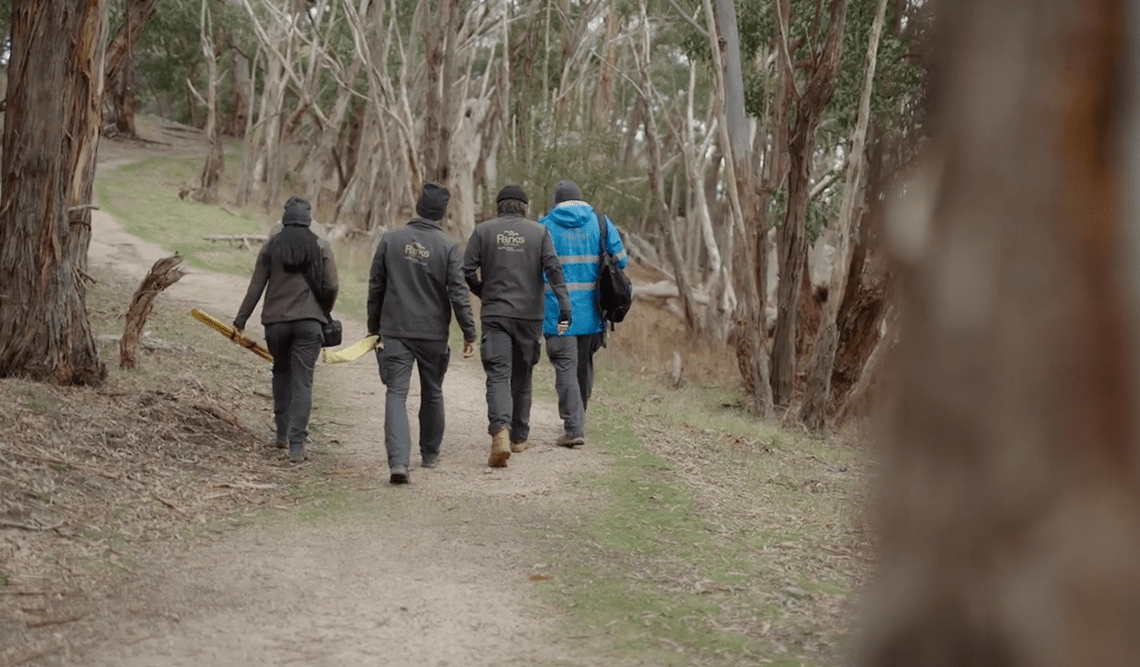For many Victorians, Castlemaine Diggings is synonymous with the gold rush: that famous period in the late 1800s when thousands of migrants flocked to Central Victoria to seek their fortunes on the gold fields. But Castlemaine Diggings Heritage National Park and its surrounding areas have a history much older and richer than the precious metal industry that briefly but dramatically occupied the landscape.
Ricki Nelson and Daikota Nelson are Parks Victoria Rangers: Daikota is a Dja Dja Wurrung Women's Ranger and Ricki is a Dja Dja Wurrung Cultural Heritage Ranger. Both are continuing a family legacy started by their grandfather, Brien Nelson, a veteran Parks Victoria Ranger Team Leader who played a pivotal role in developing land management relationships between Aboriginal people and government. Ricki and Daikota are cousins and Traditional Owners on Dja Dja Wurrung Country, where they work to protect and preserve Country and Aboriginal Heritage.
Part of this work involves looking for and documenting the extensive Aboriginal cultural heritage in these parks. "Scar trees or potential stone arrangements, scatter sites of quartz or potential artefacts, ring trees, middens, ovens, any type of Aboriginal heritage or something you can identify that was made or created by our Ancestors," says Ricki. "It's incredible, because you may have been the first person to touch that scar tree since it was cut."
"I think it's an incredible job," agrees Daikota. "It makes me feel really lucky and grateful that we're able to follow in our Grandfather's footsteps, because he worked for this Organisation for such a long time."
"Other than that," adds Ricki, "you get to just explore the most beautiful sites and places as you're walking in the untouched terrain."
Despite the beauty of the landscape, Dja Dja Wurrung Country still bears the scars inflicted during the gold rush. At the time, the mining disrupted the landscape so much that one 19th-century visitor remarked that it looked like "a great cemetery in which all the graves had been opened and emptied of their contents".

When you visit Castlemaine Diggings National Heritage Park, you'll see relics of the gold rush, from the Garfield Wheel to the Forest Creek Gold Diggings. Less visible, but no less dramatic, is the impact the gold rush had on Djaara people.
"The goldfields devastated much of Djaara Country," says Ricki. "I believe it's something like 15% of the topsoil was removed through the process of gold mining leaving nothing but destruction on local ecosystems, cultural life and habitats. Gold became sort of like a catalyst for violence and greed and land grabs, leaving my people, Djaara people, vulnerable, displaced and uncertain with where we are and who we are."
Djaara people are now working to heal their country, and to reverse what they know as "upside-down country" – country turned on its head by the gold diggings. Park visitors can help in these efforts by looking to Aboriginal people as the leaders on regenerating natural and cultural landscapes - and by learning the Aboriginal history of the areas they visit.
"Visitors should know the importance of interconnectedness of culture, the people and land," says Ricki. "We're woven together by spirit. If any one thing is impacted, whether it's positive or negative, it affects all things. The protection and preservation of these vital cultural sites and life - it needs to be done, for both the past, present and the future."
"People that are looking to dig deep into the history, the best way to find out about it is to do your research," says Daikota. "Look it up on the area that you're curious on."
"If there's anything you want to learn in the Traditional Owner Country that you're in," adds Ricki, "the best way is to try and make that connection. Because as our Grandfather used to say, we're quite willing to teach anyone."
You can learn more about Dja Dja Wurrung country at the Djaara website, and find out about the Traditional Owners where you live via the Aboriginal Cultural Heritage Register and Information System map. To learn about how to recognise and respect Aboriginal cultural heritage, see Parks Victoria's Protecting Aboriginal Cultural Heritage page, which includes an identification guide.






